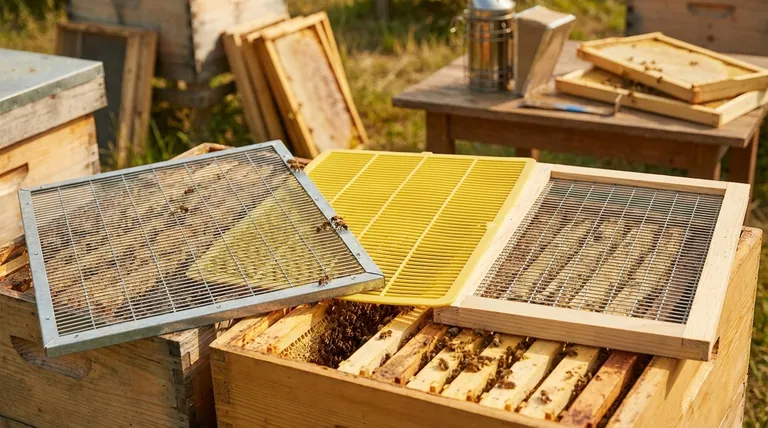The three primary types of queen excluders available for beekeepers are metal, plastic, and wood-framed. Metal excluders, often made of welded galvanized or stainless steel wire, are prized for their durability. Plastic excluders are a lightweight and more affordable alternative, while wood-framed models incorporate a metal or plastic grid into a wooden frame to ensure proper spacing within the hive.
Your choice of queen excluder ultimately balances three factors: long-term durability, upfront cost, and ease of handling. While all types achieve the same goal, understanding their material differences is key to selecting the right tool for your beekeeping philosophy and budget.

The Core Purpose of a Queen Excluder
A queen excluder is a perforated screen placed between hive bodies. The openings are large enough for worker bees to pass through but small enough to block the larger queen and drones.
Keeping Brood Out of Honey Supers
The primary function of an excluder is to confine the queen to the lower brood boxes. This ensures she cannot lay eggs in the honey supers above, resulting in clean, brood-free frames of honey for harvesting.
Advanced Hive Management
Beyond honey production, excluders are valuable management tools. They can be used to isolate the queen in a specific box to make her easier to find, to manage two-queen colonies, or even as part of an emergency swarm prevention strategy.
A Detailed Look at Excluder Types
Each material used to construct a queen excluder offers a distinct set of advantages and disadvantages.
Metal Queen Excluders (The Industry Standard)
These are typically made from welded galvanized or stainless steel wire. They have been used for decades and are considered by many to be the most reliable option.
The precise, rigid spacing of the wires provides consistent performance. Metal is exceptionally durable and will not sag or warp under normal hive conditions.
Plastic Queen Excluders (The Affordable Alternative)
Molded from a single sheet of plastic, these excluders are the most budget-friendly option, making them popular with new beekeepers or those with many hives.
They are lightweight and will not rust. However, they are less rigid than metal and can become brittle and break over time, especially with sun exposure and cold temperatures.
Wood-Framed Queen Excluders (The Hybrid Approach)
This design features a metal or plastic excluder grid set inside a wooden frame. The frame provides rigidity and, crucially, maintains the correct "bee space" between the top bars of the lower box and the bottom bars of the upper box.
This proper spacing reduces the bees' tendency to build burr comb between the excluder and the frames, making hive inspections much cleaner and easier.
Understanding the Trade-offs
Choosing an excluder involves more than just price; it impacts your workflow and the longevity of your equipment.
Durability vs. Cost
Metal excluders are a long-term investment. A well-maintained metal excluder can last for decades, whereas a plastic one may need to be replaced every few years. The higher initial cost of metal is often offset by its extended lifespan.
Ease of Cleaning
Metal is generally easier to clean. Propolis and wax can be scraped off with a standard hive tool, and the excluder can even be cleaned with a torch (with care). Plastic can be more difficult to scrape clean without gouging the material.
Impact on Bees
Any excluder can slightly slow down worker bee traffic into the honey supers. The sharp edges on some stamped metal or plastic excluders can occasionally damage bees' wings. Welded-wire metal excluders are often preferred as their smooth, rounded wires are gentler on the bees.
Making the Right Choice for Your Hive
Your specific goals should guide your decision.
- If your primary focus is maximum durability and long-term value: Choose a welded-wire metal excluder, either galvanized or stainless steel.
- If your primary focus is minimizing initial cost or outfitting many hives: A plastic excluder is a functional and economical choice.
- If your primary focus is ease of handling and maintaining correct bee space: The wood-framed excluder is an excellent option that prevents unwanted burr comb.
Ultimately, the best queen excluder is the one that fits your management style and helps you achieve your beekeeping goals.
Summary Table:
| Type | Material | Best For | Key Consideration |
|---|---|---|---|
| Metal | Welded galvanized or stainless steel wire | Maximum durability & long-term value | Highest initial cost, but longest lifespan |
| Plastic | Molded plastic sheet | Minimizing initial cost & outfitting many hives | Less rigid; may become brittle over time |
| Wood-Framed | Metal/plastic grid in a wooden frame | Ease of handling & maintaining correct bee space | Prevents burr comb; hybrid design |
Ready to equip your apiary with the right tools?
At HONESTBEE, we supply durable, high-performance beekeeping supplies and equipment to commercial apiaries and distributors through our wholesale-focused operations. Whether you're managing a few hives or a large commercial operation, the right queen excluder is key to efficient honey production and hive management.
Let us help you make the best choice for your beekeeping goals. Contact our expert team today to discuss your needs and explore our wholesale catalog.
Visual Guide

Related Products
- Beehive Entrance Discs Plastic Bee Entrance Disc for Bee Hives
- Wooden Queen Bee Excluder for Beekeeping
- Professional Plastic Queen Excluder for Modern Beekeeping
- Metal Queen Bee Excluder for Beekeeping
- Wood and Mesh Push-In Queen Cage
People Also Ask
- What equipment do you need to make honey? A Complete Guide to Starting Your Apiary
- What does a fully closed setting on a round beehive entrance disc indicate? A Guide to Hive Security
- What is the importance of understanding the function of each part of the beehive? Master Your Hive for a Thriving Colony
- What is required to be a beekeeper? Essential Equipment, Knowledge & Mindset
- What should beginners consider when purchasing beekeeping equipment? A Guide to Essential Starter Gear



















